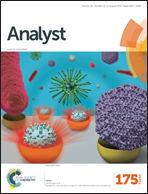Sensitive fluorescence assay of organophosphorus pesticides based on the fluorescence resonance energy transfer between CdTe quantum dots and porphyrin†
Abstract
A sensitive and selective quantum dot (QD)-based fluorescence resonance energy transfer (FRET) biosensor was successfully fabricated for the detection of organophosphorus pesticides (OPs). 5,10,15,20-Tetra(4-pyridyl)porphyrin (TPyP) with meso-pyridyl substituents was bound to the surface of CdTe QDs to produce self-assembled nanosensors, and the process of FRET between QDs and TPyP occurred. However, the process of FRET was switched off with the addition of OPs, due to the combination between TPyP and OPs. The fluorescence intensity of TPyP (donor) would decrease gradually with the increasing concentration of OPs. Under optimal conditions, a linear correlation was established between the fluorescence intensity ratio ITPyP/IQDs and the concentration of paraoxon in the range of 9.09 × 10−12–1.09 × 10−6 mol L−1 with a detection limit of 3.15 × 10−12 mol L−1. The attractive sensitivity was obtained due to the efficient FRET and the superior fluorescence properties of QDs. The proposed method was successfully applied to the determination of the OPs in real fruit samples with satisfactory results.


 Please wait while we load your content...
Please wait while we load your content...